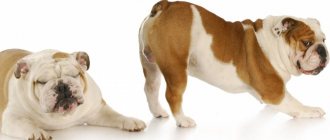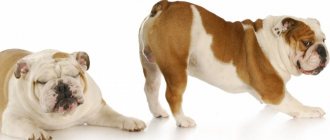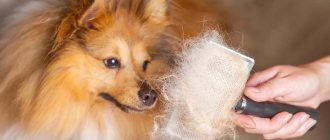Red ears in a dog are not uncommon. The hearing organs of a pet are quite vulnerable. Owners often notice that their pets scratch their ears from the inside. Looking there, you can see redness, and the ears, in most cases, are hot to the touch. It is not always possible to immediately take your dog to a veterinary hospital, so it is advisable to know the reasons for this phenomenon, and also how to provide first aid to your beloved pet.
Causes of the disease
The main cause of allergies in pugs is considered to be an innate predisposition. For effective treatment and prevention of the disease, it is necessary to distinguish between the types of allergic reactions. There are 4 main types of allergies in pugs:
- Food;
- Chemical;
- Insect;
- Ecological.
Based on this classification, the main causes of allergies in pugs can be identified: poor nutrition, high protein content in the diet, medication treatment, the body’s defense reactions to seasonal flowering of plants, autoimmune processes, insect bites, exposure to chemical animal care products.
It is difficult to identify the cause of allergic manifestations; for this you need to undergo diagnostics. Often, several days may pass from contact with the allergen to the first signs.
Allergy symptoms
Signs of the disease do not depend on the type of allergen, but are common to all types of allergies. Pugs suffer from pronounced symptoms, the main of which are:
- Drowsiness, low activity, lethargy, apathy;
- Itching and redness of the skin, the dog is constantly itching;
- Swelling in areas of inflammation;
- Baldness in affected areas;
- Increased formation of dandruff;
- Digestive problems, possible diarrhea and constipation;
- The formation of pimples and pustules is possible.
Dogs' eyes also often become cloudy and red. Pugs have a hard time with this period, so if you have one of the symptoms, you should immediately contact a specialist. Separately, it is worth mentioning the signs of allergies in pugs on the ears, which is very common in this breed.
Difficulty defecating (constipation)
A healthy dog defecates one to three times a day. If the pug does not defecate in this way, then we can say that the dog is constipated.
Most often, the situation can be solved by correcting the diet: increase the amount of cereals and vegetables in your pet’s diet. Cauliflower, zucchini and carrots are especially effective. You can add 15-20 ml of petroleum jelly to food, which is not absorbed into the body, but passes through the entire gastrointestinal tract, promoting painless bowel movements.
But sometimes constipation can be a symptom of a more serious disease - colitis. This is an inflammation of the lining of the dog's colon. Therefore, if increased attention to the pug’s nutrition has not yielded results and constipation does not subside, it is necessary to urgently contact a specialist.
Pug ear allergies
Otitis media in dogs can be caused by various factors. It happens when ear inflammation was caused by an allergic reaction - this condition of the pet is called allergic otitis. The disease develops according to the same principle as other types of allergies in animals, only in this case the pug's weakest point - the ears - is affected.
Read Causes of hematobartonellosis in dogs: signs and methods of treatment
Severe itching is provoked by the fact that the pug begins to scratch the ear, open wounds appear, and other bacteria get there, which provoke inflammation of a non-allergic etiology. To avoid undesirable consequences, you need to quickly recognize allergies in your pug’s ears. Veterinarians identify the following main signs of allergic otitis media in dogs:
- Itching, redness and dryness in the ear;
- Swelling of the ear;
- Serous discharge from the ears;
- Frequent shaking of the pug's head;
- Severe pain, the dog does not even allow you to examine the ear;
Most likely the animal has an elevated temperature. It is almost impossible for the owner to distinguish otitis of allergic etiology from other types on his own; to do this, he needs to undergo diagnostics. I wrote more about allergic otitis media here.
Hematoma of the auricle
The condition is characterized by the accumulation of blood in the cavity under the skin of the auricle. The cause is mechanical damage - bite, blow, squeezing, etc. After two or three days, a blood clot forms, and fibrin clots settle at the bottom of the hematoma. If pathogenic microorganisms get inside, an inflammatory process may develop.
Hematoma is determined by the following symptoms:
- the auricle is increased in size;
- on its outer or inner side a fluctuating, sharply limited swelling is noticeable;
- the dog is restless, shaking its head;
- sometimes (if infected) a hematoma suppurates.
Treatment of otohematoma can be carried out using two methods: conservative or surgical. Conservative involves diverting the contents of the hematoma followed by administration of a solution containing an antibiotic, novocaine and dexamethasone. This is done to reduce swelling and suppress microflora. Then apply a tight bandage. The disadvantage of this treatment is that after a few days a relapse occurs, and if after several procedures the situation does not change, they resort to the surgical method.
Surgical treatment of otohematomas consists of washing the cavity with antiseptic solutions and suturing the ear through to stop bleeding and create adhesive inflammation. This method is the most effective.
Treatment
Before starting full treatment, it is necessary to exclude the pug from contact with allergens. This could be food, animal care products, or even a product that the owner uses to wash the pet’s dishes. Limit your walks during the flowering period of various plants. If the allergen can be identified and eliminated, then treatment can begin. If it is not possible to identify the allergen, you must contact a veterinarian and carry out a diagnosis.
Local treatment
The use of topical medications is aimed at eliminating the external manifestations of inflammation, getting rid of itching and redness. Antibacterial agents are used for this. Veterinarians often prescribe complex therapy consisting of several drugs:
- Sanoderm ointment has anti-inflammatory and antibacterial properties;
- Hypoallergenic shampoos Herba Vitae, 8in1 Sensitive Shampoo or Espree Aloe Oat bath Medicated Shampoo are used to eliminate itching and redness and soothe the skin;
- To quickly heal open wounds, use Ranosan, Sanatol or Bioseptin;
In case of allergies in the pug's ears, Suprastin, Tavegil and even Diphenhydramine are prescribed. To effectively use topical medications, you must carefully clean the affected skin before use. Failure to prepare the skin area for procedures may not provide a therapeutic effect.
Read Symptoms of arthritis in dogs: 10 best drugs for treatment
Tablets, solutions and injections
The use of medications for internal use is the main step in the treatment of allergies in pugs. Prescription of drugs should be carried out by a qualified veterinarian. Typically, the treatment regimen for the disease is as follows:
- First of all, they give antihistamines - Suprastin, Tavegil, Diphenhydramine;
- The next step will be treatment of allergy symptoms and its consequences - Cyclosporine, Apoquel;
- Further, the risk of developing secondary infections in open wounds is eliminated. For this purpose, the drugs Sofradex, Otipax, Surolan are used.
- To speed up your pet's recovery, your veterinarian may prescribe immunomodulators, vitamins and minerals.
The duration of treatment depends on the severity of the allergy and the dog’s immunity. It usually takes no more than two weeks to get rid of all symptoms.
Hypoallergenic food
Poor nutrition in a pug is the most common cause of allergies in both the ears and other parts of the body. Dietary adjustment is considered the most effective way to treat it. Even if the symptoms of a food allergy have been eliminated with the help of medications, the disease can only be completely eliminated by eliminating the allergen from the diet.
It is extremely difficult to identify an allergenic food component; for this, a special mono-diet is used:
- Eliminate chicken from the diet, which very often provokes allergies in pugs. You can replace it with rabbit or lamb.
- Only rice can be given with meat; this is the only grain that does not cause allergies in 99% of cases.
- The pug should eat only rice and meat for 2 weeks. Further, it is allowed to introduce one component into the diet every 5 days.
- This way you can identify which foods cause allergies in your pug and which are hypoallergenic. The allergen must be immediately excluded from the menu.
- It is advisable to write down the foods that the owner gives to the dog and describe the pet’s reactions to them. This way you will have a list of safe and unsafe foods.
Read How to recognize allergies in a toy terrier: the best treatment methods
Bad dry food is more difficult to identify, but the principle is the same. Replace producers and types of food for 5-7 days and observe the reaction. The problem of allergies in pugs is not isolated; reviews from owners have compiled a list of safe dry food for pugs:
- Care Adult Large Breed lamb with rice;
- Golden Eagle Salmon&Potato Adult;
- Our Mark with lamb and rice;
- Monge (2.5 kg) Specialty Line Hypoallergenic – Salmon and Tuna;
- Golden Eagle Lamb&Rise;
Hypoallergenic foods are now very common and can be bought at any pet store. You should not buy large amounts of food at once; some of it may not be suitable for your pug. Allergies are a very individual phenomenon and can be caused by even the most harmless substances.
Otitis
Otitis is an inflammation of the ear. Otitis can be external, middle and internal. The causes of this disease in dogs are hypothermia, injury or bruise in the head, the presence of worms, decreased immunity, a poorly balanced diet, and allergies. The causative agents of otitis are bacteria and fungi (staphylococci and streptococci). They can be constantly present in the body, but with strong immunity they do not multiply particularly. Only a malfunction in the body leads to the rapid growth of pathogenic microflora.
Symptoms:
— The dog may scratch its ear for a long time and often shake its head, tilting it to the affected side;
— When examining the ear, swelling, purulent discharge with an unpleasant odor and redness are visible;
— The dog reacts painfully to touching its ears;
— The ear is hot, and the dog loses its appetite and looks tired.
Treatment:
1. Anti-inflammatory, analgesic and anti-itch drops (Framycetin sulfate (Sofradex), Otipax, and others).
2. If the dog has scratched the ear a lot and crusts have already formed on it, then they can be carefully removed with a swab containing hydrogen peroxide, and the wounds can be treated with a solution of brilliant green.
3. If the ear produces “squelching” sounds due to accumulated pus, it can be carefully cleaned with boric alcohol and sprinkled with powder from one streptocide tablet.
4. In addition to drops, intramuscular antibiotic injections may be required. The diet changes (often a poorly balanced “menu” is a predisposing factor in the development of otitis media), and vitamin therapy begins.
============================================================================================================================================================================================
Disease prevention
Prevention measures include eliminating the pug's contact with the allergen. We already know what can cause allergic reactions in dogs, so the use of such points will help prevent the disease:
- Eliminate allergens from food. New foods should be introduced into the diet carefully, observing the reaction to the new component for 5-7 days.
- An allergy can be caused by a medicine used to treat a pug for other diseases. If the allergy is not severe and the course of treatment is not long, then you can be patient for a while. But if the dog suffers greatly from such drugs, then it is better to replace such drugs with others.
- To care for the coat and wash your pet, use only hypoallergenic shampoos and products.
- If a pug wears special clothes, it is important what means are used to wash the clothes and what material they are made of.
- If allergies appear or become more complicated when walking, change the places for walking or limit them while the plants are flowering.
There are no special medications to prevent allergies in dogs. You need to be content only with the above methods. Using the recommendations of veterinarians, you can eliminate the problem for a long time.
Encephalitis
Encephalitis is a neurological disease, inflammation of the brain caused by pathogens. The charming pug suffers from this disease quite often. It can cause convulsions, poor coordination of the animal’s movements, and provoke aggression or lethargy unusual for the breed.
Pug encephalitis usually appears in adulthood. There is no information about the cause of the disease and, to the deepest regret of the owners, this is a disease that cannot be cured by any means. The most you can do to help your pet is to give him corticosteroids (anti-inflammatory hormones) to reduce the tumor.











